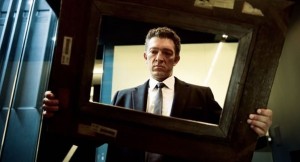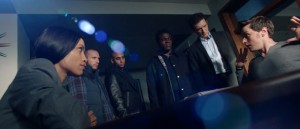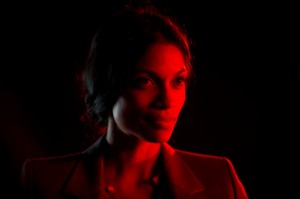Without doing any prior research into this topic, I am fully convinced 72% of movie reviewers have made a pun about Danny Boyle’s new movie Trance not putting them “under its spell.” Or something equally obvious. And while I am fairly curious how close my guess is to the actual percentage, I’m not willing to do the work of counting up the numbers because I don’t care about this film enough to put forth the effort.
Trance is a psycho-sexual thriller starring James McAvoy as Simon, an employee at an auction house who gets himself involved in an art theft scheme but gets amnesia after being hit in the head during the crime. His criminal partners, led by the violent and empathetic Franck (one Vincent Cassel), take Simon to a hypnotist to unlock the secrets of his mind to find the missing painting.
Rosario Dawson brings a cold sexuality to the role as hypnotist Elizabeth and in a moment of confused and provocative decision making, she inserts herself fully into the criminal underworld, taking over control of the operation for reasons that will be uncovered later. Or will they?
Being a thriller and crime caper, I can’t really say too much without giving away the secrets of the film’s twists. But I can say when the movie was over I didn’t care much. Trance is sterile. Cast in blueish and white hues, the film is style over substance at a level I found distracting. Being that hypnosis is the central action of the film, much of it is spent watching the reenactment of thoughts inside Simon’s head as narrated by the hypnotist. For a crime movie with murder, guns, art theft, and sex, there’s a lot of sitting around in Trance.
Danny Boyle seems to realize the problem as he tilts the camera sideways, turns up the music, and throws some redish/blueish lighting this way and that in an attempt to liven things up. As if to say “this isn’t any normal conversation, it’s trippy.” The light bounces around the flat grey stone or white walled surfaces of all the minimalistic rooms populating the film and I ask myself, “Why is it that modern sexual thrillers seem obsessed with flat surfaces and minimalistic scenery?” Everything is clean to the point of distraction. I’m sorry – but don’t high-minded stories of mental complexity and rich people take place in a messy world too?
I guess all this cleanliness is to keep us focused on the real messy part. The story. Without giving it all away, you can guess that the central role of hypnosis in the film is to create a constantly shifting concept of reality. What is real and what is hypnosis go back and forth to keep us guessing where this ride will stop. However, this movie takes a tactic to storytelling I hate. As a viewer, you basically have no chance at understanding anything. I like alternate reality, the what’s-real-and-what’s-not films. The Matrix, the original Total Recall, and even Inception deal with the topic straightforwardly. They tell you everything the characters themselves know. You have all the facts. And yet somehow you aren’t quite sure if having all the facts is enough to know what’s really going on. They don’t shy away from letting their own concept be intriguing. Total Recall is one of my favorites of this type of storytelling. Arnold Schwarzenegger’s character can’t possibly know more than the reality he’s living. It’s confusing but we don’t feel cheated because we know exactly what he knows.
Trance on the other hand has a central character who knows everything. Except we don’t know that she knows. Until she decides to tell us that she knows. Which is often. Trance is like four movies in one. Each one is the same story told with very different outcomes and each one makes me wonder why I bothered watching the first one. The rug got pulled out from under me so many times in the film that I became an advocate for hardwood floors. My understanding of what was going on changed so often that it reminded me of The Departed, another movie I didn’t really like. That one ends with a bunch of embedded criminals showing up and shooting each other in the head.
Here’s my reenactment of the ending of The Departed:
“oh – you’re not the only mole. I’m a mole too. Bang.”
“oh – you think you’re the last remaining mole? Nope. Bang.”
“oh – what about me? I’m a mole. Bang.”
I was so frustrated. Why stop at 3? Why not have 32 moles? And that’s how I felt about Trance.
“Oh… that’s not what you just saw. This is.”
“Ok, that last part I told you was a lie. Here’s the truth.”
“Oops… lied again.”
By the time the film ended I was asking myself – why stop there? Why not just keep going and give me 11 more endings? I feel like the writers saw Inception, got inspired, and wrote this. Except, while I understand the convolutions and do appreciate the inventiveness it takes to have all the facts get redefined over and over again, I was worn out and kind of hoping it would end. The flat-surfaced and sterile style sucked the remaining life out of an okay idea. In the hallway outside the theater I talked to two guys who were complaining about the same exhaustion. The were animatedly discussing whether or not the ending is really the ending and why they should believe anything. I asked if they liked the movie and the response was “well, it wasn’t boring.” True enough.
If you want to see Danny Boyle at the helm of a much better thriller, see his Shallow Grave.




You must be logged in to post a comment.